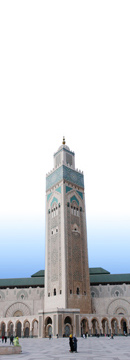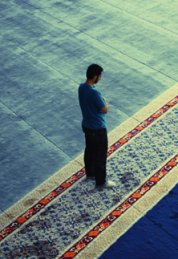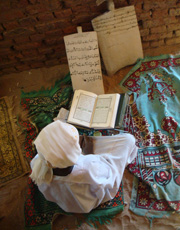Performing the Prayer
- The intention (niyyah) is one of the conditions of the prayer, without which the prayer will not be valid. The intention is the object for which the prayer is offered. Before offering the prayer, one must have in mind the intention to offer the specified prayer, as being the sunset prayer or the late evening prayer, for instance, for the purpose of worshipping Allah I. A Muslim must not announce the intention, and doing so is a mistake, for neither the prophet ﷺ, nor his noble companions ever declared it.
- He then stands in reverence and humility, raising his hands up to the level of the shoulders or a little above them, with the palms of his hands facing the qiblah, and says, as he does so, Allaahu akbar (Allah is Most Great). The takbeer (that is, the Arabic phrase Allaahu akbar) is a way of extolling and glorifying Allah I. Indeed, Allah is greater than everyone and everything else. He is greater than the life of this world and all its transitory desires. When we declare the takbeer, we leave the worldly concerns and earthly desires behind us and turn towards Allah, Most High, the All-Exalted, in great reverence and utmost humility.
- Then he places his right hand on the left hand, having both of them on his chest. He maintains this whenever he is in a standing position.
- Then He recites the opening supplication: Subhaanak-Allaahumma wa bi hamdika, wa tabaarak-asmuka, wa ta‛aalaa jadduka, wa laa ilaaha ghayruka (Glory be to You, Allah; Yours is the praise, blessed is Your name, exalted is Your majesty, and there is no god besides You). This supplication is recommended but not obligatory.
- Then he says: A‛oodhu billaahi min-ash-shaytaan-ir-rajeem (I seek Allah’s protection from Satan, who has been expelled from His mercy).
- Then he says: Bismillaah-ir-rahmaan-ir-raheem (In the name of Allah, Most Beneficent, Most Merciful).
- Then he recites Soorat Al-Faatihah, the greatest soorah in the Qur’an.
- Allah ﷻ reminds the prophet ﷺ of His favour upon him by revealing it to him: “We have given you the seven oft-repeated verses and the Magnificent Qur’an.” (Soorat Al-Hijr,15:87)
- A Muslim must learn it by heart, for reciting it in prayer constitutes one of the pillars of the prayer for those who pray alone or behind the imaam in prayers during which Qur’anic verses are recited in a low voice, such as the afternoon and late afternoon prayers.
- He says after reciting Soorat Al-Faatihah or listening to it behind the imaam: Aameen, which means “O Allah, answer my prayers.”
- After reciting Soorat Al-Faatihah,he recites another soorah or some other Qur’anic verses. In the third and fourth units of the prayer he recites only Soorat Al-Faatihah.
- Soorat Al-Faatihah and whatever Qur’anic verses are recited after it are normally recited aloud in the dawn (Fajr), sunset (Maghrib)and late evening prayers (‛Ishaa’). As for the afternoon (Dhuhr)and late afternoon prayers (‛Asr ), they are recited in a low voice.
- All the supplications are normally recited in a low voice.
- Then he recites the takbeer while raising his hands up to the level of the shoulders or a little above them, with the palms of his hands facing the qiblah, just as he has done upon reciting the first takbeer.
- Then he bows down, lowering his head and back and keeping them straight at a right angle, placing the palms of his hands on the knees. He says three times while in this position, called rukoo‛, Subhaana rabbiy-al-‛adheem (Glory be to my Lord, the Almighty). It is obligatory to say this only once, but it is recommended to say it three times. In the rukoo‛position, we must glorify and extoll Allah I.
- This means declare Him free from all defects and to recognise His absolute perfection. He recites the words Subhaana rabbiyal-‛adheem, whilst bowing, in complete humility and in total submission to Almighty Allah.
- Then he resumes the standing position, raising his hands up to the level of the shoulders or a little above them, with the palms of his hands facing the qiblah, saying Sami‛allaahu li man hamidah (Allah listens to him who praises Him). He says this whether he is praying alone or is the prayer leader (imaam). Then each one says:Rabbanaa wa lakal-hamd (Our Lord, to You is due all praise). It is recommended to say after this: hamdan katheeran tayyiban mubaarakan feehi. Mil’assamaawaati wa mil’al-ardi wa mil’a maa shi’ta min shay’in ba‛d (An abundant, beautiful and blessed praise. A praise that fills the heavens, the earth and all that You will thereafter).
- Then he recites the takbeer and prostrates himself, with the toes of both feet, the knees, the hands and the forehead touching the floor. He is recommended not to bring the arms close to the sides nor the abdomen close to the thighs, making sure that his forearms are not in contact with the floor.
- He says in this position, called sujood, Subhaana rabbiyal-a‛laa (Glory be to my Lord, Most High). It is obligatory to say this only once, but it is recommended to say it three times. The prostrate position (sujood) is the noblest state where supplications must be made to Almighty Allah. Thus, after reciting the obligatory supplication mentioned above, a Muslim is recommended to invoke Allah and humbly and earnestly ask Him for anything in this life or in the hereafter which he wants. The prophet ﷺ said, “The nearest a servant can be to his Lord is when he prostrates himself in prayer. So invoke Allah much in this state.” (Saheeh Muslim: 482) Subhaana rabbiyal-a‛laa means: I declare Allah, Most High, the Almighty, above the heavens, free from all defects. This statement reminds the worshipper, who is humbly prostrating himself before Allah, of the difference between him and his Creator, Most High, prompting him to humbly submit to Him.
- Then he recites the takbeer and sits between the two prostrations. He is recommended to sit on the left leg while keeping the right foot upright with the toes pointing towards the qiblah and resting his hands on his thighs close to the knees.
- In fact, all the sitting postures during the prayer should be done in this way, except for the sitting posture where the final tashahhud is recited, in which case it is recommended to sit with the left buttock on the ground, the right foot placed vertically with the toes pointing towards the qiblah, and the left foot on its side emerging from underneath the right foot.
- If he cannot sit in this manner for the first tashahhud or the second one due to some knee pain or because he is not used to such postures, then he can sit in a similarly comfortable manner.
- He says between the two prostrations: Rabbighfir lee, warhamnee, wahdinee, warzuqnee, wajburnee wa ‛aafinee (O Lord, forgive me, have mercy on me, guide me, provide for me, support me and protect me.).
- Then he recites the takbeer and prostrates himself in the same way as before. This completes one unit (rak‛ah) of the prayer.
- Then he rises to the standing position again, for the second unit, reciting the takbeer as he does so.
- He performs the second unit in exactly the same way as the first one.
- After the second prostration in the second unit, he takes a sitting posture and recites the first tashahhud: Attahiyyaatu lillaah, wassalawaatu wattayyibaat, assalaamu ‛alayka ayyuhannabiyyu wa rahmatullaahi wa barakaatuh, assalaamu ‛alaynaa wa ‛alaa ‛ibaad-illaah-issaaliheen, ash hadu an laa ilaaha illallaah, wa ash hadu anna Muhammadan ‛abduhu wa rasooluh (All reverence, all worship, all sanctity are due to Allah. Peace be on you, O Prophet, and the mercy of Allah and His blessings. Peace be on us and all the righteous servants of Allah. I bear witness that none is worthy of worship except Allah, and I bear witness that Muhammad is His servant and His Messenger.)
- Then he rises, reciting the takbeer, to assume a standing position and complete the rest of the prayer units if the prayer consists of three units (Maghrib) or four units (Dhuhr, ‛Asr and ‛Ishaa’). In the third and fourth units, however, he recites only Soorat Al-Faatihah. If the prayer consists of two units (Fajr), he recites the final tashahhud after completing the first tashahhud.
-
In the last unit after the second prostration, he takes a sitting posture and recites the final tashahhud. This consists of the first tashahhud mentioned earlier, which is immediately followed by the following: Allaahumma salli ‛alaa Muhammad, wa ‛alaa aali Muhammad, kamaa sallayta ‛alaa Ibraaheema wa ‛alaa aali Ibraaheema, innaka hameedun majeed. Wa baarik alaa Muhammad, wa ‛alaa aali Muhammad, kamaa baarakta ‛alaa Ibraaheema wa ‛alaa aali Ibraaheema, innaka hameedun majeed (O Allah, exalt Muhammad and the family of Muhammad, as You have exalted Abraham and the family of Abraham. Verily, You are Praiseworthy, and Glorious. O Allah, bless Muhammad and the family of Muhammad, as You have blessed Abraham and the family of Abraham. Verily, You are Praiseworthy, and Glorious.)
After this, he is recommended to recite the following supplication: Allaahumma innee a‛oodhu bika min ‛adhaabi jahannama, wa min ‛adhaab-il-qabri, wa min fitnat-il-mahyaa wal mamaati, wa min fitnat-il-maseeh-id-Dajjaal (O Allah, I take refuge in You from the punishment of the grave, from the torment of the Fire, from the trials and tribulations of life and death and from the mischief of the false Messiah.)
- Finally, he turns his face to the right side, saying: Assalaamu ‛alaykum wa rahmatullaah (Peace, and mercy of Allah be on you). Then he turns his face to the left side and says the same thing. With these greetings he concludes his prayer, as the prophet ﷺ said, “The prayer begins with the takbeer and ends with the tasleem.” (Sunan Abu Daawood: 61, Sunan At-Tirmidhee: 3) The takbeer refers to the words Allaahu akbar (Allah is the greatest of all), and the tasleem refers to the words Assalaamu ‛alaykum wa rahmatullaah (Peace and mercy of Allah be on you).
- It is recommended that a Muslim recites the following supplications after completing any of the five obligatory daily prayers:
- Astaghfirullaah, (I seek Allah’s forgiveness) three times.
- Allaahumma antas-Salaam, wa mink-as-Salaam, tabaarakta yaa dhal-jalaali wal-ikraam (O Allah, You are Peace and from You comes peace. Blessed are You, Owner of might and honour). Allaahumma laa maani‛a limaa a‛tayta, wa laa mu‛tiya limaa mana‛ta, wa laa yanfa‛u dhal-jaddi, minkal-jadd (O Allah, no one can withhold what You give, nor can anyone give what You withhold; and the might of the mighty person cannot benefit him against You.)
- Subhaanallaah (Glory be to Allah) 33 times, Al-hamdu lillaah (Praise be to Allah) 33 times and Allaahu akbar (Allah is the greatest of all) 33 times. He completes the total of one hundred by saying: Laa ilaaha illallaahu, wahdahu laa shareeka lahu, lahul-mulku, wa lahul-hamdul, wa huwa ‛alaa kulli shay’in qadeer (There is no god worthy of worship but Allah; He has no partners; the kingdom and praise belong to Him and He has power over everything)
Soorat Al-Faatihah Explained
Al-hamdu lillaahi rabbil-‛aalameen “Praise be to Allah, the Lord of all the worlds.” (1:2): I extol Allah with all His attributes, acts and apparent and hidden blessings, with due love and reverence. Rabb (translated here ‘Lord’) refers to Almighty Allah, the Creator, Owner, Provider and Disposer of all affairs. The ‘worlds’ refers to anything apart from Allah ﷻ and includes, among other things, the world of human beings, that of the jinn, that of the angels and that of animals.
Ar-Rahmaan-ir-Raheem “The Beneficent, the Merciful.” (1:3): Ar-Rahmaan (Most Beneficent) and Raheem (Most Merciful) are two of Allah’s names. Ar-Rahmaan is more intensive, in that Allah’s mercy includes in its objects the believers and the unbelievers, while Ar-Raheem has for its peculiar object the believers only.
Maaliki yawmid-Deen “Master of the Day of Judgement.” (1:4): He is the only Judge on the Day of Judgement. This statement reminds the believers of the Last Day and prompts them to do righteous deeds.
Iyyaaka na‛budu wa iyyaaka nasta‛een “You alone we worship. You alone we ask for help.” (1:5): We worship none but You, and we do not associate anyone with You in worship. We also seek only Your assistance and support in all our affairs, for the power of decision rests with you alone.
Ihdinassiraat-al-mustaqeem “Guide us on the Straight Path.” (1:6): Show us to the Straight Path and help us adhere to it until we meet You. The Straight Path (as-siraat al-mustaqeem) is nothing but Islam, the clear religion that leads to Allah’s good pleasure and Paradise. It was Muhammad r, the Seal of Prophets, who guided us to it, and man’s happiness entirely depends on adhering to it.
Siraatalladheena an‛amta ‛alayhim “The path of those You have blessed;” (1:7): That is, the path to which You have guided to, the prophets, the righteous people who know the truth and follow it.
Ghayril maghdoobi ‛alayhim waladh-daalleen “not of those who have incurred Your wrath, nor of those who have gone astray.” (1:7): Keep us away from the path of those with whom You are angry because they know the truth but have chosen not to follow it, namely the Jews and their likes; also keep us away from the path of those who have not been guided to the truth due to their ignorance, namely the Christians and their likes.

What Should a Person Who Does not Know Soorat Al-Faatihah and the Post-Obligatory Prayer Supplications by Heart Do?
A new Muslim who does not know Soorat Al-Faatihah and the post-obligatory prayer supplications by heart must do the following:
- He must do his best to memorise the obligatory supplications in the prayer, for the prayer will not be valid except by reciting these supplications in the Arabic language. These supplications are: Soorat Al-Faatihah, Allaahu akbar (Allah is Most Great), Subhaana rabbiy-al-‛adheem (Glory be to my Lord, the Almighty), Sami‛allaahu li man hamidah (Allah listens to him who praises Him), Rabbanaa wa lakal-hamd (Our Lord, to You is due all praise), Subhaana rabbiyal-a‛laa (Glory be to my Lord, Most High), Rabbighfir lee, (O Lord, forgive me), the first tashahhud, the final tashahhud, and Assalaamu ‛alaykum wa rahmatu llaah (Peace and mercy of Allah be on you).
- He must, before completing memorisation of these utterances, repeat, to the best of his ability, whatever of them he has committed to memory during the prayer and repeat whatever part of Soorat Al-Faatihah he has memorised, which is normally recited in the standing posture, for the Qur’an states, “Keep your duty to Allah as best you can.” (Soorat At-Taghaabun, 64:16)
- It is recommended that he attends the congregational prayers during this period so he can perfect his prayers and because the prayer leader (imaam) covers part of the shortcomings in the prayer of those praying behind him

 The Intention
The Intention










